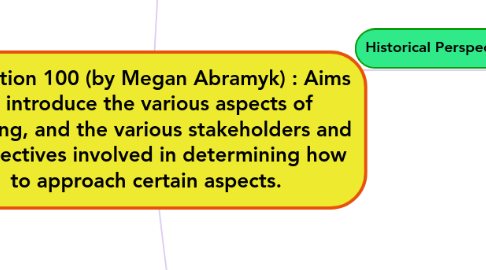
1. Historical Perspective
1.1. Structure of Schools
1.1.1. "Educational Structure is the direct product of Canadian history . . . at first religion and education were intrinsically connected, then education systems become creatures of the province" (Frank Peters).
1.1.1.1. "Canada is the only industrialized country that has no federal office or department of education" (Canadian Structure and Schools PowerPoint, slide 3).
1.2. Aboriginal Perspectives on Education
1.2.1. Learning Styles include certain strengths: experimental more than passive, visual more than verbal, oral more than written. However, "contrary to popular belief . . . there is little evidence that a stereotype learning style for all Indigenous students exists"(G.S. Aikenhead & H. Michell, 2011, p.131).
1.2.2. "In the Native story, I tried to recreate an oral storytelling voice and craft the story in terms of a performance for a general audience. In the Christian story, I tried to maintain a sense of rhetorical distance and decorum while organizing a story for knowledgeable gathering" (Thomas King, 2003, p. 22).
1.3. Eugenics
1.3.1. Sexual Sterilizations Act of Alberta, 1928 to 1972. "Historically- Eugenics was a social movement (1865- 1945) Ideologically- aimed to improve the quality of the human population, relied on science and technology" (Dr. Rob Wilson).
1.3.2. "Eugenics relies on social biases" (Dr. Rob Wilson)-is essentially socially constructed ideas of what characteristics are and are not desirable.
2. Sociological Perspective
2.1. Cultural Diversity ("Education and Diversity: Framing the Issues")
2.1.1. Gender
2.1.1.1. "The influence of gender is unmistakable in almost every aspect of schooling: the organization of work is gendered; the organization and privileging of curriculum are gendered; and results, whether measured by standardized or non standardized tests, are gendered" (Wallace, 2007, p. 1).
2.1.2. Sexual Orientation
2.1.2.1. Gender is socially constructed not biologically predetermined (Melinda McNie).
2.1.3. Race
2.1.3.1. "The 'Too Asian?' article exemplifies the contemporary form of ruling through discourse" (Cui & Kelly, 2012, p. 191).
2.1.4. Cultural Generalizations and Stereotypes
2.1.4.1. Cultural Generalization - "a tendency of a majority of people in a cultural group to hold certain values and beliefs and to engage in certain patterns of behavior" (Diversity PowerPoint, slide 15).
2.1.4.2. Cultural Stereotype - "the application of a generalization to every person in a culture or group" (Diversity PowerPoint, slide 15).
2.2. School as the Agent of Secondary Socialization (Barakett & Cleghorn, pp. 125-136, 2007)
2.2.1. "Over time teachers develop typifications of individual pupils based on appearance, language ability, etc" (as cited in Barakett & Cleghorn, pp. 125-136, 2007).
2.3. "[E]ducation has become a way to avoid dealing directly with issues such as growing social inequality, changing family structure, the perceived rise in juvenile crime, and heightened consumerism" (Kachur & Harrison, 1999, p. 202).
3. Philosophical Perspective
3.1. Education Philosophies (Martin & Loomis, 2007, p. 38-58).
3.1.1. Perenialism
3.1.2. Essentialism
3.1.3. Progressivism
3.1.4. Social Reconstructionism
3.1.5. Existentialism
3.2. Education Psychologies (Martin & Loomis, 2007, 38-58).
3.2.1. Humanism
3.2.2. Behaviourism
3.2.3. Information Progessing
3.2.4. Constructivism
3.3. Bloom's Taxonomy
3.4. Theories of Classroom Management (Manning & Kachur, pp. 47-49, 67-71, 106-119, 2012).
3.4.1. Skinner: Behaviourism
3.4.2. Lee & Marlene Canter: Assertive Discipline
3.4.3. Barbara Coloroso: Inner Discipline
3.4.4. Rudolf Dreikurs: Democratic Teaching and Management
